Part of making good video content is capturing good audio. And to do that, it’s recommended that you use an external microphone.
Dedicated camera mics allow you more control over your audio than a camera’s internal mic does, letting you change the volume, sensitivity, direction, frequency response, and noise reduction. If you’re a vlogger or presenter, you’re likely to be filming outdoors. Camera mics come in especially handy here as they block out unwanted noise like the wind.
So, to help any content creators – from newcomers to professionals – capture the sound quality they need to match the rest of the video, we’re covering the 11 best camera microphones on the market today.
In a hurry?
For those who need a quick answer, here are our top three picks and why we love them:
| Rode VideoMic-R | Produces extremely focused sound whilst the integrated Rycote shock mount system reduces handling noise. | Check the current price |
| Sennheiser MKH 416-P48U | The ultimate microphones for professionals, this is a staple in TV, film, and radio industries. | Check the current price |
| SubZero Mini Shotgun Camera Microphone | Small and lightweight yet with excellent build quality, this is great for those just starting out in content creation. | Check the current price |
The best camera microphones
1. SubZero Mini Shotgun
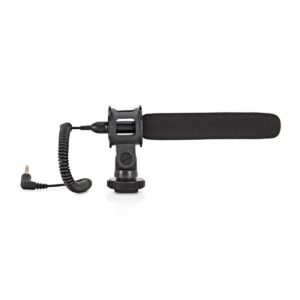 Specifications
Specifications
- Frequency Response: 50 Hz – 18 kHz
- Transducer: Condenser
- Polar Pattern: Supercardioid
Pros
- Ideal starter microphone for content creation
- Supercardioid polar pattern blocks out unwanted sound sources
- Includes shock mount with universal camera clamp for easy point-and-shoot recording
Cons
- Battery power can be a logistical challenge for longer recording sessions
The SubZero Mini Shotgun Camera Microphone is a game-changer for content creators. it offers a supercardioid polar pattern designed to pick up sound from a focused area in front while minimising background noise, making it an excellent choice for interviews or location recordings where you want the focus to be on your subject.
The lightweight design of this microphone is another big plus, especially if you’re someone who’s always on the move. It’s easy to carry around and won’t add unnecessary weight to your gear. But don’t let its lightness fool you. The SubZero Mini Shotgun is housed in a rugged metal chassis, making it durable enough to withstand the demands of recording outside.
And it doesn’t stop there. This microphone comes with a windshield and camera shock mount. The windshield helps reduce wind noise when recording outdoors, while the shock mount helps to eliminate handling noise. Together, they ensure that your audio quality remains top-notch, regardless of where you’re recording.
Given its features and the value it provides, the SubZero Mini Shotgun Camera Microphone is certainly a solid choice for content creators, especially for beginners looking to take that first leap in audio quality.
2. Sennheiser MKH 416-P48U
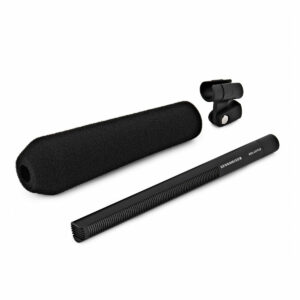 Specifications
Specifications
- Frequency Response: 40 Hz – 20 kHz
- Transducer: RF Condenser
- Polar Pattern: Supercardioid
Pros
- Premium sound and build quality ideal for professional use
- Supercardioid polar pattern provides detailed directivity that silences unwanted noise
- Extremely low noise with fully floating balanced output
Cons
- High price and premium build not suited to beginners
The Sennheiser MKH 416-P48U Super Cardioid Shotgun Microphone is a quintessential tool for those in film, radio, and television industries. This microphone is an incredibly powerful and useful capture device for on-location recording.
The MKH 416-P48U’s hypercardioid polar pattern is designed to deliver a concentrated, focused sound while simultaneously rejecting off-axis noise and ambience. But despite its powerful capabilities, the MKH 416-P48U boasts a compact design that allows for precise positioning.
Its size has been crafted with discretion in mind, meaning you can get up close to the audio source without the worry of the microphone appearing in the scene and disrupting the magic of the moment.
Plus, the MKH 416-P48U does not shy away from diverse environments. It’s immune to humidity, making it just as adaptable and comfortable on location as it is in the confines of a studio. This robustness and adaptability are what make it an invaluable tool for content creators across various industries.
3. Rode VideoMicro
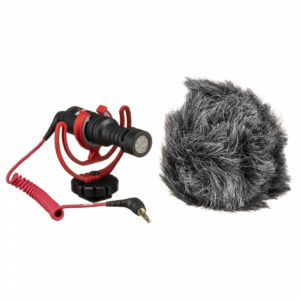 Specifications
Specifications
- Frequency Response: 100 Hz – 20 kHz
- Transducer: Electret Condenser
- Polar Pattern: Cardioid
Pros
- Helix isolation mounting system prevents handling noise for cleaner sound
- Included windshields reduce unwanted weather noise or plosives, even under harsh conditions
- Compact and highly portable design ideal for location recording or streaming outdoors
Cons
- Doesn’t include USB cables despite USB connectivity
The Rode VideoMicro is an incredibly compact shotgun microphone meticulously designed for smaller cameras and mobile devices. Equipped with a Rycote Lyre shock mount, this high-quality on-camera microphone isolates handling noise, providing crystal-clear audio in every recording.
An additional deluxe furry windshield is included, perfect for outdoor recording sessions where it effectively eliminates unwanted noise.
The mic boasts a lightweight aluminium body which provides a high level of RF rejection, and it’s finished with a high-grade ceramic anti-glare black coating. Thanks to a cardioid pick-up pattern, the VideoMicro also ensures that only sound from directly in front of it is captured. Any sound from the sides is rejected, resulting in natural, detailed audio.
Mounting the VideoMicro is a breeze – the microphone fits snugly into its shockmount which can be slotted neatly into your hot shoe mount. Its versatility extends further as this tiny microphone can also be mounted off-camera onto a boom pole or mic stand. With no batteries required, the VideoMicro is ready to start capturing incredible audio as soon as it is plugged in.
4. Shure VP83 LensHopper
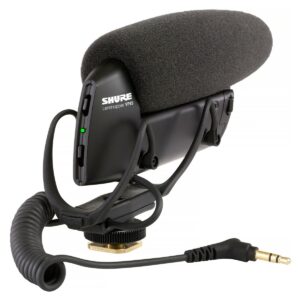 Specifications
Specifications
- Frequency Response: 50 Hz – 20 kHz
- Transducer: Condenser
- Polar Pattern: Supercardioid
Pros
- High-quality tailored frequency response captures important details
- On-board storage lets you record audio on the microphone itself as well as to-camera for backups
- Rycote Lyre shock mount system for high-quality isolation
Cons
- Thinner low-end response than some alternatives
Designed for DSLR cameras and portable audio recorders, the Shure VP83 LensHopper shotgun mic is both compact and powerful. It’s great for content creators desiring crystal-clear sound quality.
One particularly great feature that makes it good for video audio is its supercardioid polar pattern. This advanced design shields your audio from wind noise and ambient sounds, allowing for clear, natural sound reproduction that’s purely the audio you want. Whether you’re filming indoors or braving the elements outdoors, the VP83 ensures your audio remains pristine.
Also contributing to this clear sound is the VP83’s wide frequency range, high sensitivity, low self-noise, and comprehensive end response. With all these, you can expect a sound that is authentic, full-bodied, and free from distortion.
Incorporating a Rycote Lyre shock mount system, the VP83 effectively isolates vibrations and mechanical noise, ensuring quiet operation. An additional foam windscreen provides an extra layer of protection against wind noise during outdoor filming sessions.
Operating on a single AA battery, the VP83 offers up to 130 hours of continuous use – pretty impressive!
5. Rode VideoMic-R
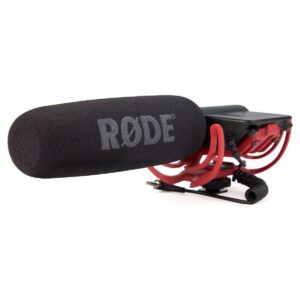 Specifications
Specifications
- Frequency Response: 40 Hz – 20 kHz
- Transducer: Condenser
- Polar Pattern: Supercardioid
Pros
- Supercardioid polar pattern focuses response to avoid unwanted sounds
- Integrated Rycote shock mount system for reducing handling noise
- Two-stage high-pass filter to reduce low-frequency rumble and three-step pad control
Cons
- Windscreen isn’t thick or well-suited to intense weather conditions
A premium-grade shotgun mic, the Rode VideoMic-R is designed to deliver studio-grade audio fidelity, making it an indispensable asset for content creators.
At the heart of this mic are a condenser capsule and a supercardioid polar pattern. Designed to record directly in front of the microphone, it maintains the focus on your subject while eliminating outside noise. This results in a clearer and more precise recording.
There’s also an ultra-wide frequency range, meaning you can capture every nuance of your source audio in great detail. This ensures a high-quality finished product, where your picture is matched with studio-grade audio.
To further enhance the recording quality, a two-step high-pass filter is included, eliminating low-end noise such as traffic or electrical equipment. A built-in three-step pad then allows for attenuation of the microphone to different environments, ensuring the perfect take every time.
6. Behringer Video Mic X1
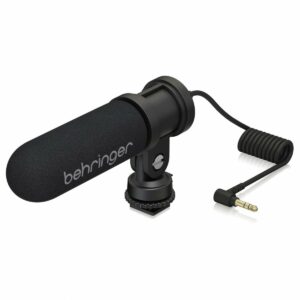 Specifications
Specifications
- Frequency Response: 50 Hz – 18 kHz
- Transducer: Condenser
- Polar Pattern: Omnidirectional
Pros
- Dual-capsule stereo design provides an immersive sound quality
- X-Y capsule arrangement places objects in space accurately
- Optional battery or camera-powered operation ensures reliability
Cons
- Omnidirectional polar pattern can capture sounds you don’t want due to its even, circular shape
As far as camera microphones go, the Behringer Video Mic X1 stands out as a solid choice for content creators. It’s not just about its compact size and portability, although those certainly help when you’re always on the move. It’s also about the quality of sound it can deliver.
The dual-capsule X/Y condenser design of this microphone ensures that you capture high-quality audio every time. Whether you’re vlogging in a bustling city or capturing the sounds of nature in a tranquil forest, the Video Mic X1 has got you covered.
What’s more, it comes with a high-performing shock mount. This means that you don’t have to worry about handling noise ruining your recordings. Just mount it onto your camera, and you’re good to go.
Build quality is another area where the Video Mic X1 shines. It feels solid and well-made, offering great value for money. Plus, its resonance tube design enables it to capture more natural sound compared to many other microphones in the market.
7. Sennheiser MKE 400
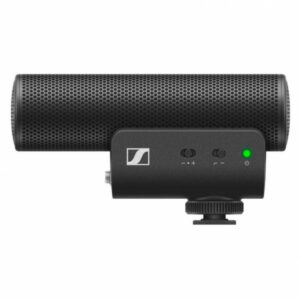 Specifications
Specifications
- Frequency Response: 50 Hz – 20 kHz
- Transducer: Condenser
- Polar Pattern: Supercardioid
Pros
- Lightweight supercardioid condenser offers a detailed sound for content and film
- Three-stage gain sensitivity settings and low-cut filter to prevent rumble or distortion
- Dual TRS and TRRS connectivity for use with DSLR cameras or smartphones
Cons
- Lacks more advanced features for anyone who really wants to dig into their sound
The Sennheiser MKE 400, a compact and highly directional on-camera microphone, is an excellent tool for content creators aiming for top-notch audio quality. Its design focuses on isolating and enhancing the audio for your video, making it ideal for vloggers, filmmakers, and interviewers who need clear, crisp sound.
A notable feature of the MKE 400 is its integrated wind protection and internal suspension. This feature minimises wind noise and handling noise, ensuring that the focus remains on the subject’s voice. Plus, the microphone’s rugged all-metal housing assures durability, meaning it can withstand the rigours of on-the-go shooting.
One of the best things about the MKE 400 is its compatibility with both cameras and smartphones. So, whether you’re shooting with a professional DSLR or your trusty iPhone, this microphone has got you covered.
Remember, in the world of content creation, audio quality matters as much as visual quality. And with the MKE 400, you’re one step closer to achieving professional-level audio in your videos.
8. Sennheiser EW-DP
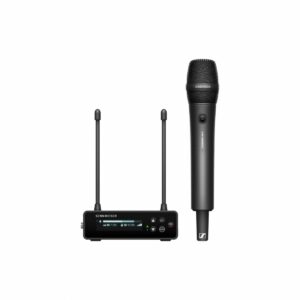 Specifications
Specifications
- Frequency Response: Microphone-dependent
- 40 Hz – 16 kHz (835 capsule)
- 50 Hz – 18 kHz (ME 4)
- 30 Hz – 20 kHz (ME 2)
- Transducer:
- Dynamic (with 835 capsule and handheld transmitter)
- Condenser (with ME 4 or ME 2 lavalier microphone)
- Polar Pattern:
- Cardioid (835 capsule or ME 4 lavalier)
- Omnidirectional (ME 2 lavalier)
Pros
- Wireless system removes challenge of cables
- Wide range of microphones available to suit your recording style
- Smart Assistance automatically responds to or notifies you of issues cropping up as you record for consistently clean sound
Cons
- Stationary receiver means less mobile whilst filming than camera-mounted mics
The Sennheiser EW-DP Series is a range of wireless systems for speech recording. Coming in two frequency bands, this series has options for license-free use in most of the territories around Europe you could expect to find yourself in, making it a great option for travel-focused creators as well as those who just want to be free from the tangle of cables while filming.
This series has four specific configurations, giving you plenty of options for recording however you prefer.
The 835 Set features a handheld wireless transmitter with a capsule based on Sennheiser’s lauded e835 handheld microphone. ME 2 boasts Sennheiser’s omnidirectional lavalier mic and a lightweight bodypack, whilst the ME 4 Set also has a bodypack and lav mic, but this time with a front-facing cardioid polar pattern for noise rejection.
Finally, the ENG Set gives you the ME 2 omnidirectional lavalier, a bodypack, and a plug-on transmitter for using handheld transmitters too.
Another main benefit of the EW-DP series is its digital UHF architecture, blending the stability and clarity of digital wireless systems with the feature-rich design of typically analogue UHF systems. This allows it to have a premium sound quality, incredibly solid wireless signal transmission with few dropouts, and minimal noise and interference.
It also comes with automatic frequency coordination, meaning that even if sudden noise starts clogging up the clear channel you started with, it’ll detect it and switch to a clean one before it ruins your recording.
The EW-DP range was designed with ease of use at the forefront, making it extremely accessible for beginners and experienced creators alike. Its Smart Notifications system warns you of issues it runs into from the moment you start using it, so if anything needs your input as you record, it’ll send a message the second it detects an issue. You can fix it without technical issues plaguing your content.
9. Mackie EM-98MS
 Specifications
Specifications
- Frequency Response: 30 Hz – 20 kHz
- Transducer: Condenser
- Polar Pattern: Supercardioid
Pros
- Highly portable shotgun condenser microphone
- High-pass filter and windscreens to prevent low-frequency rumble and weather or handling noise
- Headphone output for monitoring directly on the microphone
Cons
- Non-removable battery means you must always keep track of charging
The Mackie EM-98MS Camera & Smartphone Shotgun Microphone gives you broadcast-quality audio and elevated recordings right from the moment you hit record.
It features a high-directivity design, ensuring that the microphone captures focused sound while minimising background noise. This makes it perfect for interviews, vlogs, and any content where clear, professional-grade audio is crucial.
What’s more, the Mackie EM-98MS is as convenient as it is capable. Its compact and lightweight build makes it a cinch to carry around and set up, so you can take it wherever your creativity leads. And with the handy headphone-out feature, you can monitor your recordings in real time, ensuring everything sounds just right.
One of the best things about this microphone is its rechargeable lithium-ion battery. This means you don’t have to worry about running out of power halfway through a recording session. Simply charge it up, and you’re good to go!
10. IK Multimedia iRig Mic Video
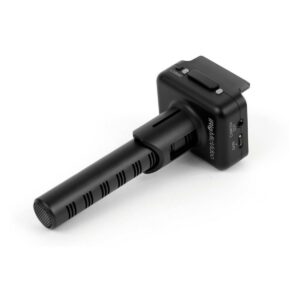 Specifications
Specifications
- Frequency Response: 20 Hz – 20 kHz
- Transducer: Condenser
- Polar Pattern: Supercardioid
Pros
- Includes preamp and A/D converter for a complete solution
- Excellent sound quality and low noise floor
- Versatile and easy to use
Cons
- USB power connector isn’t always secure
The IK Multimedia iRig Mic Video is a fantastic tool for content creators. This microphone stands out for its ability to deliver crystal-clear audio, making your videos sound as good as they look. It’s compatible with a wide range of devices, including smartphones, tablets, and DSLRs, which adds to its versatility and makes it a practical choice for different recording scenarios.
One of the standout features of the iRig Mic Video is its adjustable gain control and LED monitoring. These allow you to have complete control over your audio levels, ensuring that your sound is always on point.
Equipped with a gold-sputtered condenser capsule, this microphone captures rich and detailed sound. The supercardioid pattern further enhances the audio quality by ensuring noise-free recordings. Better still, there’s a headphone-out, which allows for real-time monitoring. This means you can listen to your audio as you record and make necessary adjustments on the spot.
11. Tascam TM-200SG
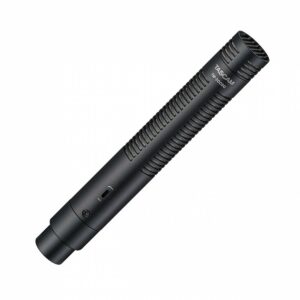 Specifications
Specifications
- Frequency Response: 30 Hz – 20 kHz
- Transducer: Condenser
- Polar Pattern: Supercardioid
Pros
- Compact and lightweight makes portability and camera mounting easy
- Clear, warm sound quality
- Low-cut filter for eliminating rumble
Cons
- Windscreen isn’t heavy-duty enough for higher winds
The Tascam TM-200SG Shotgun Condenser Microphone is a brilliant companion for content creators who want to elevate their audio game. This microphone’s ability to deliver clear, high-quality sound makes it ideal for various applications such as film shooting, vlogging, presenting, and more.
One of its standout features is its compact and lightweight design. This makes it incredibly easy to attach to a camera, allowing content creators to focus more on their craft and less on setup. Plus, it doesn’t add any significant weight to your gear, making it perfect for on-the-go shooting.
But it’s not just about convenience. The TM-200SG boasts a supercardioid polar pattern, designed to pick up sound from a focused area while minimising unwanted background noise. This means you can record in various environments without the worry of distracting noises ruining your audio.
Additionally, this microphone operates on 48V phantom power, eliminating the need for an extra power supply. This feature further adds to the convenience and portability of the mic. And for those tricky situations where low-frequency noise might be an issue, the TM-200SG has a switchable low-cut filter to handle that.
The Tascam TM-200SG Shotgun Condenser Microphone is a versatile, convenient, and high-quality microphone that can significantly enhance the audio in your content creation. Whether you’re a vlogger, podcaster, or filmmaker, this microphone could be the perfect tool to help take your work to the next level.
Jargon buster
There are some fancy words thrown about when it comes to shopping for microphones. Here’s what they all mean:
Polar pattern
The polar pattern represents the direction from which the microphone will pick up sound. This is relative to the front of the capsule. The most common polar patterns are omnidirectional, cardioid, supercardioid, hypercardioid, and bidirectional. If you want to know about each of these polar patterns in detail, we have a whole in-depth guide on the topic!
Frequency response
It seems self-explanatory, but a mic’s frequency response is the range of frequencies that a microphone can pick up and respond to. Regular human hearing ranges from 20 Hz to 20 kHz, so we tend to want camera microphones to capture this full range and sound flat and even.
Phantom power
In camera microphones, phantom power is an additional, external voltage required to power them. This is only ever required with condenser capsules, but without a phantom power source, you won’t get any sound whatsoever.
Shotgun microphone
A shotgun microphone is a type of microphone shaped like a long, thin cylinder. Shotgun microphones are highly directional, meaning they tend to have an extremely accurate polar pattern that cancels out sounds which are away from the front of the microphone. The only exception to this is if a shotgun microphone has an omnidirectional polar pattern, in which case they’ll pick up in all directions equally.
Shotgun microphones are often used for film, TV, broadcasting, and videography, due to their neutral sound and their ability to be mounted on top of and powered by cameras.
Lavalier microphone
Lavalier microphones are small, discrete microphones that can be hidden in or clipped onto clothing to capture speech. They’re often used in conferencing, broadcasting, film, and TV, sometimes in conjunction with a shotgun microphone, giving you multiple mics to edit for optimal sound quality.
Lavaliers come in a range of types and sizes, but they usually have some sort of clip and are popular for their ability to remain hidden and out of the way. Looking specifically for a lav mic? Our picks of the best lavalier mics are a great place to start.
Large-diaphragm condenser
Large-diaphragm condensers are a type of microphone typically used in studio recording or live sound. Since they’re larger than a lavalier, it can be difficult to use these in video content, however, they’re well-suited to recording voiceovers, as well as podcasting or streaming.
Like other condensers, they require phantom power. They are sensitive to louder noises, but give you a lot more detailed sound reproduction. Large-diaphragms also tend to impart some sort of sound to what they’re capturing, whereas lavaliers or shotgun microphones give you flatter, more natural audio.
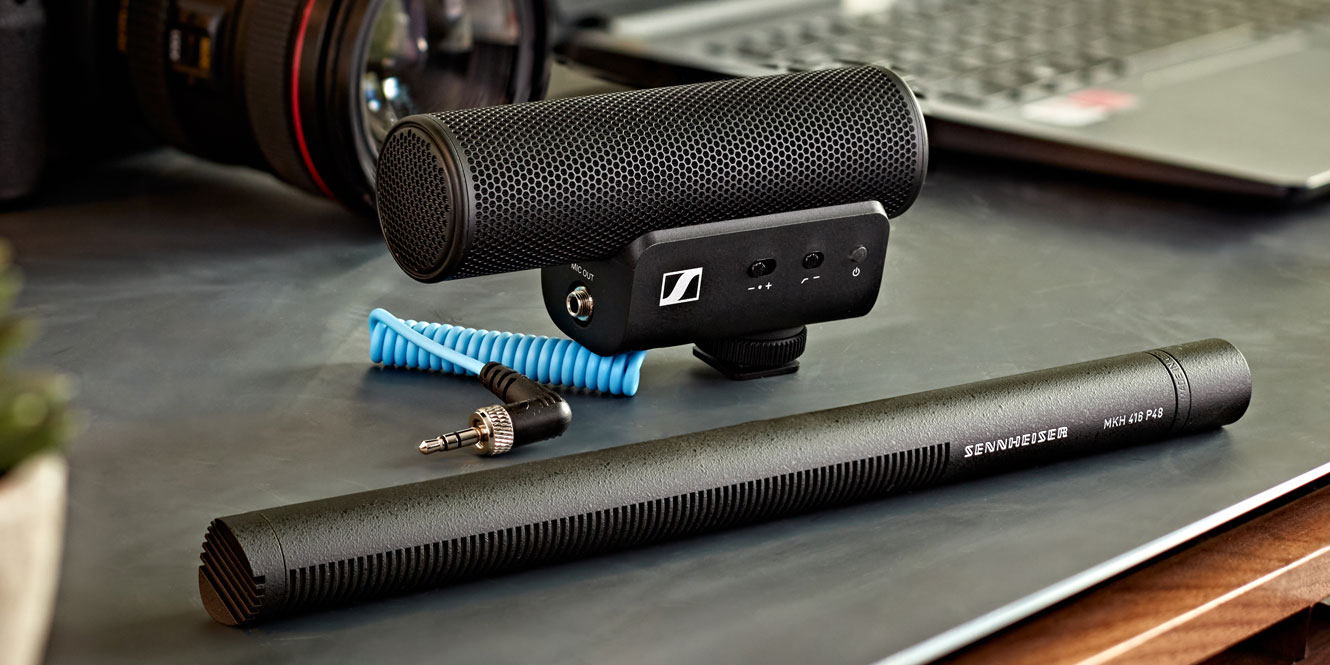
Things to consider when buying a microphone for your camera
There are a few things worth considering when deciding which microphone you want for your camera.
Of course, cost will always be a primary factor. What can you afford to purchase and maintain? As with all audio equipment, you might not just have the initial purchase to consider. Batteries, accessories, storage… other costs might affect which microphone you choose and how well you can operate and maintain it, so checking what’s included is also important.
The next thing you should consider is whether you’re after a shotgun or lavalier microphone. If you’re having trouble narrowing it down, our guide to lavalier microphones should help you decide which is the best choice for your needs.
You have to like the sound quality of the microphone you’re buying, so it’s worth checking demos, testing units, or asking someone who owns one of the models you’re considering about its sound and if you can try it for yourself. Polar pattern fits into this too. What and how you’re recording should give you an idea of the external sound sources you might want to avoid capturing. Do you want a full sound field or a focused pickup?
You should also consider the practicalities of using the microphones you like most. Does it fit your workflow? Is it lightweight and portable? Does it feel sturdy and stable enough? Does it comfortably mount or connect to your smartphone or camera? These are all good questions to ask yourself. It’s also worth factoring in power. Do you want battery power, phantom power, or both? Do you want a wired design or something wireless?
FAQs
Which is the best camera mic?
Our favourite camera mics are:
- Rode VideoMic-R
- Sennheiser MKH 416-P48U
- SubZero Mini Shotgun Camera Microphone
- Shure VP83 LensHopper
- Sennheiser MKE 400
What type of microphones do cameras typically use?
For on-camera use, either a shotgun microphone or lavalier microphone is typically used. Shotgun microphones are great for an all-in-one solution that can be synchronised with your camera, whilst lavalier microphones are better for being discrete or hidden within clothing.
Do I need an external microphone for the camera?
An external microphone is important if you want to improve the audio quality of your videos. Many built-in camera microphones are lacking in detail, have a high noise floor, or don’t handle louder sounds well and create a lot of distortion. If these are issues you want to fix to improve your content, an external microphone is the best way to go.
Final thoughts
So, now we’ve covered some of the best camera microphones for content creation, we hope you can go into your next recording sessions feeling confident that you’ll not only look professional but sound it too!

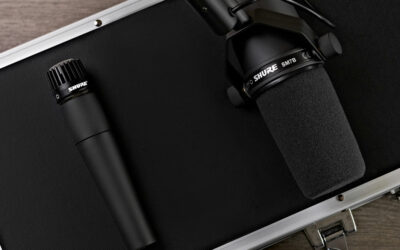
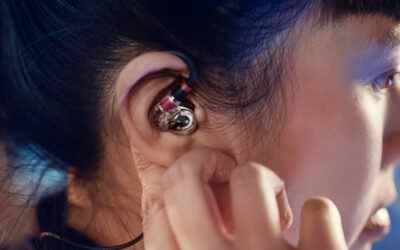
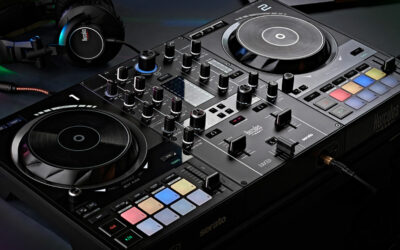

0 Comments